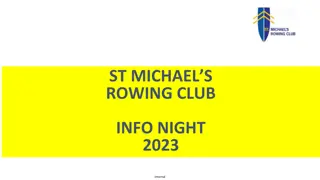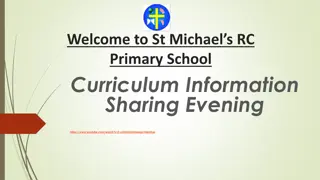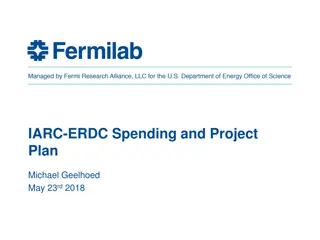Geographic Support System Initiative (GSS-I) Overview
The Geographic Support System Initiative (GSS-I) aims to enhance address data quality through partnerships with tribal, state, county, and local governments. This program involves acquiring, verifying, and geocoding address data, with a focus on improving address coverage and spatial accuracy. Reengineering address canvassing processes in 2019 has led to significant advancements in address data management. The GSS-I emphasizes continuous data updates and collaboration to ensure accurate and up-to-date information for planning and decision-making.
- Geographic Support System Initiative
- Address Data Quality
- Data Partnership
- Address Canvassing
- Spatial Accuracy
Uploaded on Dec 15, 2024 | 0 Views
Download Presentation

Please find below an Image/Link to download the presentation.
The content on the website is provided AS IS for your information and personal use only. It may not be sold, licensed, or shared on other websites without obtaining consent from the author. Download presentation by click this link. If you encounter any issues during the download, it is possible that the publisher has removed the file from their server.
E N D
Presentation Transcript
NYSDC Affiliate Meeting Michael Horgan Geographer, Address Programs Management Division michael.j.horgan@census.gov 617-447-4111 May 7-8, 2015 1
Topics Background and progress on The Geographic Support System Initiative (GSS-I) Update on the 2020 Local Update of Census Address (LUCA) program 2
The GSS-I Partnership Program Opportunity for tribal, state, county, and local governments to continually exchange address & spatial data with the Census Bureau Recognizes partner governments as a definitive authority for quality address and street data within their communities 3
What is the Basic Process? 1. Acquire partner data and perform Content Verification to determine general usability 2. Crosswalk, standardize, match, and geocode partner addresses and structure points using the Master Address File (MAF) 3. Match street centerline data to identify differences, calculate spatial accuracy (CE95 method) of partner data using GPS control points 4. Ideal Scenario: new addresses are added to the MAF, new streets are added to TIGER, address and spatial inconsistencies are submitted for resolution 4
Key Components of the GSS-I An integrated program that utilizes a partnership program for: Improved address coverage transaction-based address and spatial feature updates Enhanced quality assessment and measurement Address Updates Quality Measurement Stock Photo of Construction of house motor10 Street/Feature Updates secn1_normaldistribution 123 Testdata Road Anytown, CA 94939 Lat 37 degrees, 9.6 minutes N Lon 119 degrees, 45.1 minutes W 5
Reengineered Canvassing in 2019? 2009 Address Canvassing 100% Canvassing vs 2019 Reengineered Canvassing 6
Reengineering Address Canvassing In-office and In-field work MAF/TIGER updates from GSS-I Maximizing the use of the DSF Research and use other sources of addresses, including administrative records and commercial data Using the MAF and imagery to detect change 7
GSS-I in New York State 2013, MOU with New York State Office of Information Technology Services (ITS) NY Street Address Mapping (SAM) Counties received 45 counties NY ITS 5 counties directly from local government 9
New York Counties received - GSS-I Albany Allegany Bronx * Cattaraugus Cayuga Chemung Clinton Columbia Cortland Delaware Dutchess Erie Essex Franklin Genesee Greene Hamilton Herkimer Jefferson Kings* Lewis Livingston Madison Monroe Montgomery Nassau New York* Niagara Oneida Ontario Orange Orleans Oswego Putnam Queens* Richmond* Rockland St. Lawrence Saratoga Seneca Steuben Suffolk Sullivan Tioga Tompkins Ulster Warren Washington Westchester Wyoming 10 Livingston
Block Level Address Feedback Consists of block tallies detailing: What the partner provided Number of records matched or added to the Census address list Number of records not accepted Total number of residential records currently in the MAF 11
Feature Feedback http://www.census.gov/geo/partnerships/bas/bas_dowlo ad.html> partnership shape files include date of last update 12
2020 Census Local Update of Census Addresses (LUCA) Program 13
Background LUCA1998/99: First opportunityfor tribal and local governmentsto reviewand update theCensus Bureau s address list. 2010 LUCA: Based on Census 2000 feedback, threeparticipation optionswere offered: Option 1:Title-13 Full Address ListReview (similar toLUCA 1998) Option 2:Title-13 review , full address listsubmission Partners provide their entire residential address list withaccess to Title-13 addresses Option 3:Non-Title-13, full address listsubmission Partners provide their entire residential address list without access to Title- 13addresses 1 4
2020 LUCAImprovement Research To developpotentialalternativedesigns for LUCA 2020 based on research by four subteams LookingBack at 2010 (assessments,surveys,lessons learned) Impactof Geographic Support SystemInitiative(GSS-I)on LUCA (utilizingaddress data, software and processesfor LUCA) Reengineered Address Canvassing s impacton LUCA (in- officevalidation) FocusGroups 1 5
LUCARecommendations 1. Continue the 2010Census LUCA Programimprovements that were successful Continue to provide a120-dayreview time for participants. Continue the six month advance notice about the LUCA program registration Continue a comprehensive communicationprogramwith participants Continue to provide avariety of LUCA media types Continue to improvethe partnership softwareapplication Continue State participationin the LUCA program 2. Eliminate the full address listsubmission options that were availablein 2010LUCA (Options2and 3). This will: Reduce the number of deleted LUCA recordsin fieldverification activities Reduce the burden and costof processing addresses and LUCA address validation 1 6
LUCARecommendations (continued) 3. Reduce the complexity of the LocalUpdate of Census Addresses Program 4. Include census housingunit location coordinatesinthe census address list and allowpartners to return their housingunit location coordinatesas part of their submission 5. Provide anyungeocoded United States PostalService Delivery Sequence File addresses to State and County partners 6. Provide the address listin morestandardformats 7. Conduct an in-officevalidationof LUCA submitted addresses 8. Utilize GSS-I dataand tools to validate LUCA submissions 1 7
LUCARecommendations (continued) 9. Encourage governments at the lowestlevel to work withhigher-level governments to consolidate their submission. 10.Eliminate the Block Count Challenge 11.Eliminate the use of the asterisk(*) designation for multi-units submitted without unit designations 12.Encourage LUCA participants to identify addresses used for mailing, location,or both 10
CurrentActivities/Next Steps Investigate the technicalrecommendations for 2020LUCA: Use of background imageryon paper maps Ability to provide structure locationswithinLUCA materials Feasibility of webbased registration Determine feasibility of using areas where we have planned field activities to validate LUCA records Work with OMB to develop a 2020 LUCA Appeals process 19
For more information, please visit: http://www.census.gov/geo/www/gss/ http://www.census.gov/2020census Thank You Michael.j.Horgan@census.gov 617-447-4111 20























